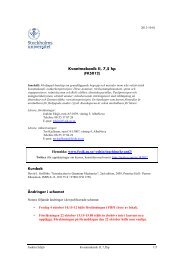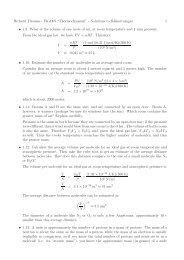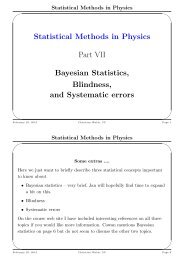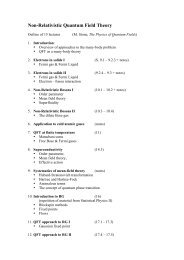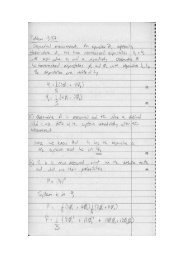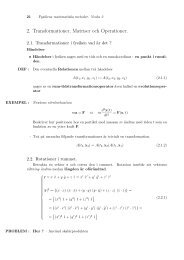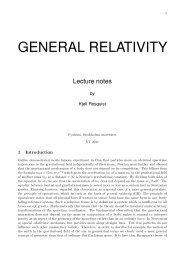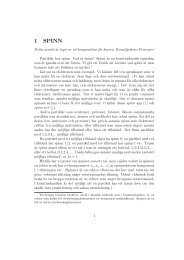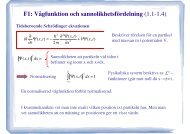Final Examination Paper for Electrodynamics-I [Solutions]
Final Examination Paper for Electrodynamics-I [Solutions]
Final Examination Paper for Electrodynamics-I [Solutions]
You also want an ePaper? Increase the reach of your titles
YUMPU automatically turns print PDFs into web optimized ePapers that Google loves.
<strong>Final</strong> <strong>Examination</strong> <strong>Paper</strong> <strong>for</strong> <strong>Electrodynamics</strong>-I<br />
Date: Saturday, Jan 03, 2009, Time: 09:00 - 15:00 [<strong>Solutions</strong>]<br />
Allowed help material: Physics and Mathematics handbooks or equivalent<br />
Note: Please explain your reasoning and calculations clearly<br />
Questions: 1 2 3 4 5 6 Total<br />
Marks: 13 13 13 13 14 14 80<br />
1. (a) Consider a charge q placed a distance d in front of an infinite plane conductor<br />
kept at zero potential. Determine the potential Φ(x) at any point in front of<br />
the conductor using the method of images.<br />
(b) Consider the Poisson equation, ∇ 2 φ = −4πρ, in a volume V with a boundary S<br />
over which Φ satisfies either Neumann or Dirichlet boundary conditions. Write<br />
down the corresponding Green’s function equation and express the solutions Φ<br />
in terms of the Neumann or Dirichlet Green’s functions.<br />
Solution (points: 13)<br />
a) For simplicity, choose a coordinate system such that the z-axis is perpendicular<br />
to the conducting plane and the charge q lies on the z-axis with position vector dˆz.<br />
By the symmetry of the problem, the image charge q ′ should also be located on the<br />
z-axis at some position −ˆzd ′ . Then, at some point x with respect to the origin of<br />
our coordinate system, the potential is given by<br />
φ(x) =<br />
q<br />
|x − ˆzd| +<br />
q ′<br />
|x + ˆzd ′ | .<br />
For points x on the conducting surface, φ(x|surface) = 0, but also , x · ˆz = 0. Hence,<br />
0 =<br />
q<br />
q<br />
+<br />
|x2 + d2 | ′<br />
,<br />
|x2 + d ′2 |<br />
and it should hold <strong>for</strong> all values of x = |x|. Simple manipulations then show that<br />
d ′ = d and q ′ = −q. The potential at any point is then given by<br />
φ(x) =<br />
q<br />
|x − ˆzd| −<br />
q<br />
|x + ˆzd| .<br />
b) The solution is outlined here (<strong>for</strong> details see Jackson’s section 1.8 and 1.10, 3 rd<br />
edition): The Green’s function equation corresponding to the Laplace equation is<br />
∇ 2 G(x − x ′ ) = −4πδ(x − x ′ ) ⇒ G(x − x ′ ) =<br />
1<br />
1<br />
|x − x ′ | + F (x, x′ ) ,
where ∇ 2 F (x, x ′ ) = 0 within the volume V and F is chosen such that G satisfies<br />
specified boundary conditions on the boundary S of V . Now, in Green’s second<br />
identity, <br />
d<br />
V<br />
3 x ′ (ψ1∇ ′2<br />
ψ2 − ψ2∇ ′2<br />
ψ1) = ds<br />
S<br />
′ ∂ψ2 ∂ψ1<br />
(ψ1 − ψ2 ) ,<br />
∂n ′ ∂n ′<br />
choose ψ1(x ′ ) = φ(x ′ ) and ψ2(x ′ ) = G(x − x ′ ) to get the <strong>for</strong>mal solution to the<br />
Laplace equation,<br />
<br />
φ(x) =<br />
V<br />
d 3 x ′ ρ(x ′ )G(x − x ′ ) + 1<br />
4π<br />
<br />
S<br />
<br />
ds ′<br />
<br />
G(x − x ′ ) ∂φ<br />
∂n ′ (x′ ) − φ(x ′ ) ∂<br />
∂n ′ G(x − x′ <br />
) .<br />
For Dirichlet boundary conditions on φ, we are given φ(x ′ ) <strong>for</strong> all x ′ on the surface<br />
S. Then on G we need the Dirichlet boundary conditions<br />
leading to<br />
<br />
φ(x) =<br />
V<br />
GD(x − x ′ ) = 0, <strong>for</strong> all x ′ on S ,<br />
d 3 x ′ ρ(x ′ )GD(x − x ′ ) − 1<br />
<br />
ds<br />
4π S<br />
′<br />
<br />
φ(x ′ ) ∂<br />
∂n ′ GD(x − x ′ <br />
) .<br />
For Neumann boundary conditions on φ, we are given ∂φ<br />
∂n ′ (x ′ ) <strong>for</strong> all x ′ on S. However,<br />
we cannot simply impose ∂<br />
∂n ′ G(x − x ′ ) = 0 since this contradicts the defining<br />
equation <strong>for</strong> G. Then the simplest boundary condition is<br />
∂<br />
∂n ′ G(x − x′ ) = − 4π<br />
A , <strong>for</strong> all x′ on S ,<br />
where A is the total area of the boundary S. This leads to the solution<br />
<br />
φ(x) = 〈φ〉S + d 3 x ′ ρ(x ′ )GN(x − x ′ ) + 1<br />
<br />
4π<br />
ds ′<br />
<br />
GN(x − x ′ ) ∂φ<br />
∂n ′ (x′ <br />
)<br />
V<br />
where 〈φ〉S is average value of φ over the surface S.<br />
2. (a) Consider an electric dipole of moment p placed at the origin. Evaluate the<br />
electrostatic potential at a point x generated by this dipole.<br />
(b) Consider a macroscopic volume V within a polarized dielectric material containing<br />
free charges of density ρf(x ′ ) and a dipole moment density P (x ′ ). Compute<br />
the electric potential φ(x) due to free charges and dipoles within V. Express<br />
polarization charge density ρpol and the electric displacement vector D in<br />
terms of P .<br />
Solution (points: 13)<br />
a) A dipole is constructed from charges q and −q a distance y apart. In the setup<br />
given, the midpoint of y is the origin of the coordinate system. Then the potential<br />
at any point x is given by,<br />
Φ(x) =<br />
q<br />
|x − y/2| −<br />
q<br />
|x + y/2| .<br />
2<br />
S<br />
,
Expanding in powers of 1/x (where x = |x|),<br />
1<br />
|x ∓ y/2|<br />
= 1<br />
x<br />
y · x<br />
± + · · · .<br />
2x3 Then, in the limit y → 0, keeping p = qy fixed, we obtain the dipole potential<br />
Φ(x) =<br />
p · x<br />
x 3 .<br />
b) In a medium of dipole moment density P (x), the dipole moment in volume ∆V<br />
around a point x ′ is ∆V P (x ′ ). This contributes to the electrostatic potential at x as<br />
∆V P (x ′ ) · (x − x ′ )/|x − x ′ | 3 . Then the total potential at x is<br />
<br />
Φ(x) =<br />
The second term becomes<br />
<br />
d<br />
V<br />
3 x ′<br />
d<br />
V<br />
3 x ′ P ′<br />
(x ) · ∇ ′<br />
(<br />
<br />
ρf(x ′ )<br />
|x − x ′ | + P (x ′ ) · (x − x ′ )<br />
|x − x ′ | 3<br />
<br />
1<br />
|x − x ′ <br />
) = − d<br />
| V<br />
3 x ′ ∇ ′ · P (x ′ )<br />
|x − x ′ ,<br />
|<br />
where we have dropped a surface term arising from an integration by parts. Now,<br />
using ∇ 2 (x) (1/|x − x′ |) = −4πδ(x − x ′ ), one gets<br />
∇ · E = 4π(ρf − ∇ · P ) .<br />
Thus, we see that −∇ · P = ρpol can be regarded as an effective charge density<br />
due to the polarization of the medium. The above equation can also be rewritten as<br />
∇ · ( E + 4π P ) = 4πρf. In terms of the electric displacement vector D = E + 4π P ,<br />
this becomes ∇ · D = 4πρf.<br />
3. (a) Consider a length l of thin conducting wire, through which a current I flows,<br />
placed in a magnetic field B. Derive the expression <strong>for</strong> the <strong>for</strong>ce that acts on<br />
the wire segment. For a rectangular wire loop of height L and width w placed<br />
in a uni<strong>for</strong>m magnetic field which is perpendicular to the sides of length L,<br />
compute the net <strong>for</strong>ce and torque acting on the the wire loop.<br />
(b) Show that, in time dependent situations, the equation ∇ × B = (4π/c) J is not<br />
consistent with charge conservation. Derive the modified equation by requiring<br />
consistency with charge conservation.<br />
Solution (points: 13)<br />
a) The Lorentz <strong>for</strong>ce acting on a volume element d3x within the current distribution<br />
is d F = 1<br />
c (ρd3x)v× B so that the <strong>for</strong>ce on the volume V is F = 1<br />
<br />
c V J(x)× B(x) d3x. For a wire we can write d3x = ds · dl with dl along the length of the wire and ds a<br />
surface element over the cross section of the wire. In the thin wire approximation,<br />
3<br />
.
J is parallel to dl and the variation of B over the cross section can be neglected.<br />
Then, <br />
V d3x J(x) × B(x) = <br />
l S ( ds · dl)( J × B) = <br />
l S ( ds · J)( dl × B). This gives<br />
the <strong>for</strong>ce on wire l due to the magnetic field B as,<br />
F = I<br />
<br />
dl ×<br />
c<br />
B .<br />
l<br />
Now consider a rectangular current loop with its height L parallel to the z-axis,<br />
placed in a uni<strong>for</strong>m magnetic field B in the ˆy direction. Clearly the loop edges of<br />
length w are in the x − y plane. Let θ denote the angle between the vector normal to<br />
the loop area and the magnetic field B along ˆy. Clearly this also is the angle between<br />
the edge of length w and the x-axis. Now using the above <strong>for</strong>mula, the <strong>for</strong>ces on<br />
the two edges Lˆz and −Lˆz are ∓(I/c)LBˆx, respectively. The <strong>for</strong>ces on the top and<br />
bottom edges of length w become ±(I/c)wB cos θˆz. The total <strong>for</strong>ce adds up to zero.<br />
As <strong>for</strong> the torque, the <strong>for</strong>ces along ˆz act colinearly and produce no torque. The pair<br />
of <strong>for</strong>ces along ˆx are not colinear and produce a torque τ = w × F , where w denotes<br />
the vector length of top edge of the loop. Then,<br />
τ = wF sin θ ˆz = (I/c)wLB sin θ ˆz .<br />
b) Taking the divergence of both sides of the equation, the left hand side vanishes<br />
∇ · ( ∇ × B) = 0. But, on using the continuity equation, the right hand side is<br />
proportional to ∇ · J = −∂ρ/∂t which is non-zero in time dependent situations.<br />
Hence in these cases, the equation is not consistent with charge conservation. To<br />
restore consistency with charge conservation, we have to modify J on the right hand<br />
side to some J + · · · so that the new quantity always remains divergenceless. Such a<br />
quantity is obtained by combining the continuity equation with the Maxwell equation<br />
∇ · E = 4πρ which gives, ∇ · ( J + 1<br />
becomes ∇ × B − 1 ∂<br />
c<br />
E<br />
∂t<br />
= 4π<br />
c J.<br />
4π ∂ E/∂t) = 0. Hence, the modified equation<br />
4. Consider Maxwell’s equations in a medium of constant permittivity ɛ and permeability<br />
µ in the absence of sources.<br />
(a) Show that the equations admit plane-wave solutions. Determine the velocity<br />
of the plane wave and explain the index of refraction.<br />
(b) Show that E, B and the wave vector k are all perpendicular to each other.<br />
Solution (points: 13)<br />
a) To show that Maxwell’s equations in the absence of sources admit plane wave<br />
solutions, one first shows that they reduce to wave equations <strong>for</strong> E and B. For this,<br />
take curls of the two equations containing ∇ × E and ∇ × B and simplify using<br />
the vector identity ∇ × ( ∇ × E) = −∇2E + ∇( ∇ · E). Now use the remaining two<br />
Maxwell equations to get decoupled wave equations of E and B,<br />
<br />
∇ 2 − µɛ<br />
c2 ∂2 ∂t2 <br />
<br />
E = 0 , ∇ 2 − µɛ<br />
c2 ∂2 ∂t2 <br />
B = 0 .<br />
4
These admit plane wave solutions,<br />
E = E0e i( k·x−ωt) , B = B0e i( k·x−ωt) , with k 2 = µɛ<br />
c 2 ω2 .<br />
From the wave equations or from the solutions, one can read off the wave velocity<br />
in the medium as v = c/ √ µɛ. The index of refraction <strong>for</strong> electromagnetic waves in<br />
a medium is given by n = c/v = √ µɛ.<br />
b) For the above solutions, ∇· E = ik · E and ∇× E = ik × E with similar results <strong>for</strong><br />
B. Then the Maxwell equations ∇ · E = 0 and ∇ · B = 0 imply k · E = 0, k · B = 0.<br />
So E and B are perpendicular to the wave vector k. Now substituting the solutions<br />
in the remaining two Maxwell’s equations gives k × E = ω<br />
c B and k × B = − ω<br />
c E<br />
which proves that E and B are also perpendicular to each other.<br />
5. (a) Starting with Maxwell’s equations in the presence of sources, introduce the<br />
potentials A and Φ and rewrite the equations in terms of the potentials in the<br />
Lorenz gauge.<br />
(b) Write down the solution <strong>for</strong> A in terms of the spherically symmetric retarded<br />
Green’s function (the Green’s function need not be derived) <strong>for</strong> a localized<br />
source with a sinusoidal time dependence, J(x, t) = J(x)e −iωt . How does one<br />
characterize the Near, Intermediate and Far zones? Discuss the solution in the<br />
Near zone.<br />
Solution (points: 14)<br />
a) Let us consider the two homogeneous equations (the ones without sources). ∇· B =<br />
0 implies that one can always express the magnetic field as B = ∇ × A. Using this,<br />
the remaining homogeneous equation becomes, ∇×( E + 1<br />
c ∂ A/∂t) = 0, which implies<br />
the existence of a scalar potential such that E = − ∇Φ − 1<br />
c ∂ A/∂t = 0.<br />
Now we substitute these into the equations with sources. ∇ · E = 4πρ gives,<br />
∇ 2 Φ + 1<br />
c<br />
∂<br />
∂t ( ∇ · A) = −4πρ .<br />
The Maxwell equation sourced by J gives (on using ∇×( ∇× A) = −∇2A+ ∇( ∇· A)), <br />
∇ 2 A 1<br />
−<br />
c2 ∂2A ∂t2 − <br />
∇ ∇ · A + 1<br />
<br />
∂Φ<br />
= −<br />
c ∂t<br />
4π<br />
c J .<br />
The Lorenz gauge condition ∇ · A + 1(∂Φ/∂t)<br />
= 0 decouples these two equations<br />
c<br />
giving,<br />
∇ 2 Φ − 1<br />
c2 ∂2Φ ∂t2 = −4πρ , ∇2A 1<br />
−<br />
c2 ∂2A = −4π<br />
∂t2 c J .<br />
b) The solution of the above equation <strong>for</strong> A in terms of the spherically symmetric<br />
retarded Green’s function is<br />
A(x, t) = 1<br />
<br />
d<br />
c<br />
3 x ′<br />
<br />
J(x ′ ′ , t )<br />
ret<br />
|x − x ′ ,<br />
|<br />
5
where the numerator is to be evaluated at the retarded time t ′ = t−|x−x ′ |/c. Hence,<br />
<br />
J(x ′ ′ , t )<br />
=<br />
ret<br />
J(x ′ , t ′ = t − |x − x ′ |/c), and <strong>for</strong> the given sinusoidal current,<br />
A(x, t) = e−iωt<br />
c<br />
<br />
d 3 x ′ J(x ′ ) e ik|x−x′ |<br />
|x − x ′ |<br />
where k = ω/c (= 2π/λ, say). There are three length scales in the problem: 1)<br />
the linear extension of the current distribution denoted by d (then, with the origin<br />
of the coordinate system chosen within the current distribution, one has x ′ d),<br />
2) the length λ which is the distance that a signal travels during one oscillation of<br />
the source (note that 2π/ω = T is the time period of the oscillating source), 3) the<br />
distance to the observer denoted by x = |x|. For a well localized source, we always<br />
assume that d
In the expression, Pµνρ = ∂µFνρ + ∂ρFµν + ∂νFρµ, the indices are not summed over.<br />
Moreover using the antisymmetry of Fµν one can show that Pµνρ is antisymmetric<br />
under the exchange of any two of its indices. So it is non-zero only when µ, ν, ρ all<br />
take different values. Now, there are too possibilities: (1) all indices take spacial<br />
values, say, µ = i, ν = j, ρ = l. Since each index can take only 3 values, all choices<br />
are equivalent to µ = 1, ν = 2, ρ = 3. (2) One index denotes time and the two<br />
other space, say, µ = 0, ν = j, ρ = k. In case (1), writing Fij = −ɛijkB k , one gets<br />
P123 = − 3<br />
k=1 (ɛ23k∂1B k + ɛ12k∂3B k + ɛ31k∂2B k ). In each term, the value of the<br />
index k cannot be the same as either of the other two indices on the ɛ-tensor. Hence<br />
it has to equal the third possible value, which is the index on the derivative. Then,<br />
using ɛ123 = 1.<br />
P123 = −ɛ123(∂1B 1 + ∂2B 2 + ∂3B 3 ) = − ∇ · B = 0 ,<br />
In case (2), P0ij = ∂0Fij + ∂jF0i + ∂iFj0 = ∂0F ij − ∂jF 0i − ∂iF j0 . Now, <strong>for</strong> {i, j} =<br />
{1, 2}, {1, 3}, {2, 3}, one gets<br />
P012 = −(∂0B 3 + ∂1E 2 − ∂2E 1 ) = −( ∇ × E + 1<br />
c<br />
∂ B<br />
∂t )3 ,<br />
and the corresponding expressions <strong>for</strong> P013 and P023. Hence one recovers the two<br />
sourceless Maxwell equations.<br />
In a different Lorentz frame, the two expressions ∂µF µν − 4π<br />
c J ν and ∂ µ F νρ +∂ ρ F µν +<br />
∂ ν F ρµ take the <strong>for</strong>m<br />
˜∂˜µ ˜ F ˜µ˜ν − 4π<br />
and<br />
c ˜ J ˜ν = L ˜ν ν(∂µF µν − 4π<br />
c J ν ) ,<br />
˜∂ ˜µ ˜ F ˜ν ˜ρ + ˜ ∂ ˜ρ ˜ F ˜µ˜ν + ˜ ∂ ˜ν ˜ F ˜ρ˜µ = L ˜µ µL ˜ν νL ˜ρ ρ(∂ µ F νρ + ∂ ρ F µν + ∂ ν F ρµ ) ,<br />
where L ˜µ µ are the components of the Lorentz trans<strong>for</strong>mation matrix. These expressions<br />
have exactly the same <strong>for</strong>m in the two frames and when the equations in the<br />
original frame are satisfied, the corresponding equations in trans<strong>for</strong>med frame also<br />
hold.<br />
b) The electric potential φ(x) and magnetic potential A(x) combine into a 4-vector<br />
A µ = {A 0 = φ, A} which under Lorentz trans<strong>for</strong>mations L trans<strong>for</strong>ms as<br />
à µ (˜x) = L µ νA ν (L −1 ˜x) .<br />
In our case, A = 0 and the non-trivial components of L are, L 0 0 = L 1 1 = γ,<br />
and L 1 0 = L 0 1 = −γβ. There<strong>for</strong>e Lorentz trans<strong>for</strong>mation gives (suppressing the ˜x<br />
dependence)<br />
˜φ = γφ , Ã 1 = −γβφ , Ã 2 = Ã3 = 0 .<br />
To complete the trans<strong>for</strong>mation, we have to express the x µ dependence of φ in terms<br />
of ˜x µ . For the given Lorentz trans<strong>for</strong>mation, x1 = γ(˜x 1 +β˜x 0 ), x2 = ˜x 2 and x3 = ˜x 3 ,<br />
so that x2 = 3 1 xixi = γ2 (˜x 1 + v˜t) 2 + (˜x 2 ) 2 + (˜x 3 ) 2 . Then,<br />
˜φ(˜x)<br />
Q<br />
= γ <br />
(γ2 (˜x 1 + v˜t) 2 + (˜x 2 ) 2 + (˜x 3 ) 2 ) , Ã1 = −β ˜ φ(˜x) .<br />
7


![Final Examination Paper for Electrodynamics-I [Solutions]](https://img.yumpu.com/21085948/1/500x640/final-examination-paper-for-electrodynamics-i-solutions.jpg)
